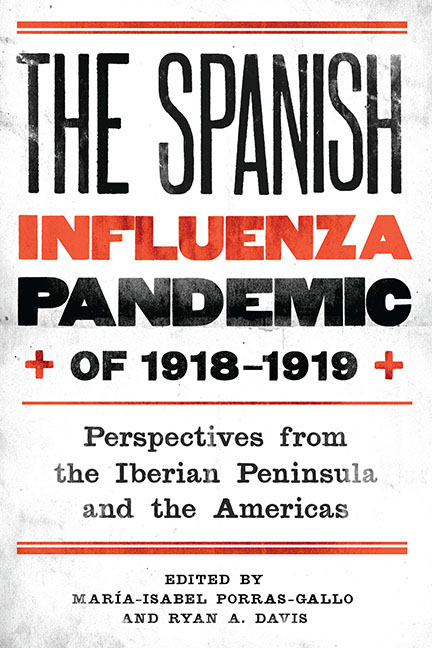 The Spanish Influenza Pandemic of 1918–1919
The Spanish Influenza Pandemic of 1918–1919 Book contents
- Frontmatter
- Dedication
- Contents
- Introduction: Emerging Perspectives of the Spanish Influenza Pandemic of 1918–19
- Part One Scientific Discourse: Now and Then
- Part Two Social Responses: Human and Institutional Actors
- 4 And to Make Things Worse, the Flu: The Spanish Influenza in a Revolutionary Portugal
- 5 Between the Pandemic and World War I: The 1918–19 Influenza Pandemic in the Spanish Army, through the Eyes of the Press
- 6 The Reign of the Spanish Flu: Impact and Responses to the 1918 Influenza Pandemic in Minas Gerais, Brazil
- 7 The Spanish Flu in Bahia, Brazil: Prophylaxis and Healing Practices
- 8 A Collaborative Experience: The Mutual Benefit Societies’ Responses to the 1918–19 Influenza Pandemic in Pamplona, Spain
- Part Three Interpreting the Epidemic: Sociocultural Dynamics and Perspectives
- Selected Bibliography
- List of Contributors
- Index
8 - A Collaborative Experience: The Mutual Benefit Societies’ Responses to the 1918–19 Influenza Pandemic in Pamplona, Spain
from Part Two - Social Responses: Human and Institutional Actors
Published online by Cambridge University Press: 14 March 2018
- Frontmatter
- Dedication
- Contents
- Introduction: Emerging Perspectives of the Spanish Influenza Pandemic of 1918–19
- Part One Scientific Discourse: Now and Then
- Part Two Social Responses: Human and Institutional Actors
- 4 And to Make Things Worse, the Flu: The Spanish Influenza in a Revolutionary Portugal
- 5 Between the Pandemic and World War I: The 1918–19 Influenza Pandemic in the Spanish Army, through the Eyes of the Press
- 6 The Reign of the Spanish Flu: Impact and Responses to the 1918 Influenza Pandemic in Minas Gerais, Brazil
- 7 The Spanish Flu in Bahia, Brazil: Prophylaxis and Healing Practices
- 8 A Collaborative Experience: The Mutual Benefit Societies’ Responses to the 1918–19 Influenza Pandemic in Pamplona, Spain
- Part Three Interpreting the Epidemic: Sociocultural Dynamics and Perspectives
- Selected Bibliography
- List of Contributors
- Index
Summary
The influenza pandemic that wreaked havoc in Europe in 1918 was an ordeal for the societies it affected, as evidenced by governments’ efforts to fight it, health professionals’ responses to it, and the general population's behavior. Scholarly attention to these issues has expanded our understanding of the epidemic beyond what we learn from morbimortality data, which are important in their own right. Nevertheless, relatively little work has been done on nongovernmental and not-for-profit organizations during the 1918–19 epidemic, despite current broader interest in the provision of welfare services “outside the purview of the State” from individuals, families, mutual-aid associations, and private charities. This chapter examines the pandemic from the point of view of the mutual benefit societies (MBSs) in Spain—whose work became vital for the attention received at the time by workers and their families—to shed light on the history of these societies and their relationship with the state system and other public administrations as well as on the 1918–19 influenza pandemic.
We look specifically at the effort of the physicians employed by these societies in Pamplona, Spain. As a general rule, these societies were linked to the social hygiene movement that became prominent in Europe at the beginning of the twentieth century as a means to social reform. They were known for assisting authorities in fostering health care practices, and they played a leading educational role in the improvement of health among the inhabitants of Pamplona during the first two decades of the twentieth century. In this period Spanish activists and physicians, frequently funded by private charity with hardly any support from public authorities, organized medical-social campaigns to improve the public health of society.
At the time of the influenza epidemic, Pamplona had the same medical health care systems as the rest of Spain. At the turn of the twentieth century the Spanish sanitary structure were based on nineteenth-century models, which had shifted from the social assistance characteristic of the Ancien Régime to a humanitarian model more in keeping with the liberal state.
- Type
- Chapter
- Information
- The Spanish Influenza Pandemic of 1918–1919Perspectives from the Iberian Peninsula and the Americas, pp. 152 - 170Publisher: Boydell & BrewerPrint publication year: 2014


